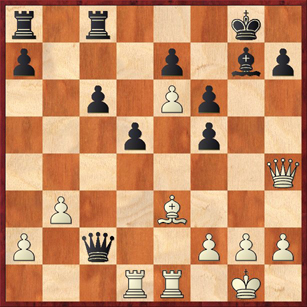Here’s an interesting position from a game I played quite a long time ago:
Mackenzie — Stauffer, Columbus Invitational 1993
What is White’s best move and why?
While you’re mulling that over, let me say a little bit about why I was going over this game. Last week Valeri Lilov, the newest ChessLecturer, gave a really nice lecture called “Attacking Chess: Time is Everything.” He went over a game between Vassily Ivanchuk and Artur Yusupov from 1991, in which Yusupov basically sacrificed his whole queenside while playing a mating attack on the kingside. Lilov’s point was that instead of defending Ivanchuk’s threats, which would have cost him time, Yusupov just kept pressing ahead on the kingside, which actually gained time because Ivanchuk was losing tempi by swallowing all of Yusupov’s queenside pieces. (To be fair to Ivanchuk, it isn’t quite that simple; a grandmaster would never blindly capture material to no purpose. Ivanchuk really thought that he could capture and at the same time put his pieces in a position to defend; it took some wonderful magic tricks by Yusupov, including a queen sacrifice, to prove otherwise.) If you aren’t a member of ChessLecture, you should at least look the game up on www.chessgames.com. It’s truly inspiring.
But what grabbed me about the game was the pawn formation, which was very reminiscent of this game that I played against Craig Stauffer back in 1993. Both games featured what I call a “bone in the throat” — a very far-advanced pawn (at e3 for Black, or at e6 for White) that disrupts the coordination in the opponent’s position and at the same time makes life uncomfortable for the opponent’s King. By the way, you can also have a “bone in the throat” on other squares; f6, for example, is a good one. I don’t think a pawn on the fifth rank ever qualifies, though; the pawn has to be on the sixth or seventh to be a bona fide bone in the opponent’s throat.
The position in the diagram is quite reminiscent of Ivanchuk-Yusupov. White has sacrificed a pawn in order to ram the e-pawn down Black’s gullet, and White is perfectly prepared to give up the rest of his queenside pawns, because he believes that Black will not have time to capture them and defend his kingside. Notice, in particular, how completely ineffecitve Black’s rooks and bishop are; really the only piece that can possibly come to the aid of Black’s king is the queen. At the moment, the Black queen is threatening to come to e4, which would bring a rapid end to White’s attack.
With my usual lack of subtlety, I played 21. Rd4 in this position, defending the threat and preparing a rook lift over to the kingside. My opponent found the nice response 21. … f4!, which opens a diagonal for Black’s queen to defend the kingside. After 22. Rxf4 Qxa2 (not what was played in the game) 23. Rg4 Kh8 24. Qh5 Qxb3 25. Rh4 Qc2 Black has succeeded in gobbling a couple pawns and bringing his queen back in time to defend h2. However, the position is still winning if White finds the move 26. f4! (the computer came up with this) and the threat of f5, cutting the queen off from the kingside, is unstoppable.
So 21. Rd4 does seem to win, but the win was perhaps unnecessarily difficult. Can you find a better plan for White in the diagrammed position? To give you even more of a clue, what would Nimzovich do?
The answer is: Blockade! Thanks to our e6 pawn, Black’s two rooks and the bishop are already crippled pieces. All White needs to do is shut out Black’s queen, and there will be nothing left to defend the kingside. So the clearly lethal plan here is 21. Bf4! The pawns are blockaded, and Black’s queen is totally cut off. There is absolutely nothing that he can do to prevent 22. Qh5 (protecting the rook on d1), followed by Re3 (the other rook!) followed by Rg3 or Rh3 with mate soon to follow.
There is something a little bit sadistic about Nimzovich’s style, and 21. Bf4 is sadistic in exactly the same way. It’s like flipping a bug onto its back before you squash it; the bug can wiggle its legs all it wants, but cannot do anything to avert its fate.
Another Nimzovichian concept that could have led me to find the move 21. Bf4 is the idea of prophylaxis. I had to anticipate that … f4 was Black’s only way to create any counterplay, and play the prophylactic move 21. Bf4 to prevent it.
The way the game actually ended, beginning at the diagrammed position, was 21. Rd4 f4 22. Rxf4 c5 23. Rc1 Qd3 24. Rg4 Kh8 25. Qg3 Rg8 26. Bxc5! Qf5 (Black doesn’t want to trade queens because the endgame will just be lost) 27. Re1 Bh6 28. h3! (A good double-purpose move, creating luft for the king and defending the rook; White doesn’t want to cede the g-file to Black with 28. Rxg8+) 28. … Bd2 29. Re2 Qb1+ 30. Kh2 and I eventually won 46 moves later in a rook-and-pawn endgame. Not bad, but a good deal less tidy than Nimzovich’s way!




{ 1 comment… read it below or add one }
People could not believe their eyes at 19. g4??This gruqtseoe blunder had already been committed by Naroditsky at a slower time control, US Champ. qualifiers in Tulsa, OK. There, also as white, he played g4?? donating f4 to Friedel and Friedel duly won!
{ 1 trackback }